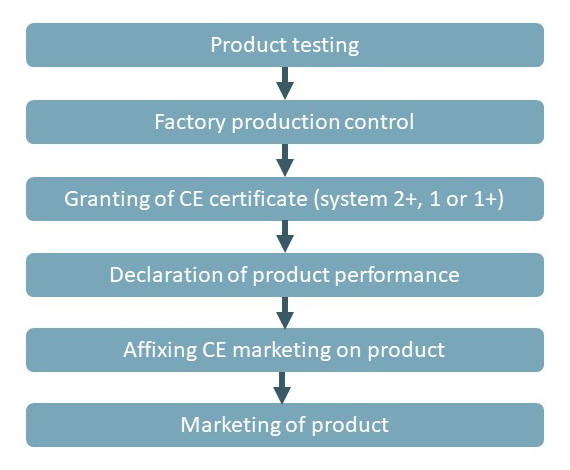Regulatory CE marking is generally mandatory for launching a product on the market. The purpose of CE marking is to facilitate the free movement of products within the European Economic Area, because it indicates a product's compliance with the basic requirements of the European regulations and directives, including the Construction Products Regulation (CPR).
The Construction Products Regulation (EU regulation no. 305/2011) entered into force on July 1, 2013, and requires that all construction products compliant with a harmonized standard or a European Technical Assessment have a Declaration of Performance and bear CE marking in order to be placed on the market.
CE marking is not a sign of quality, but rather a sign of compliance, primarily intended for the market surveillance authorities. It is featured on all products that meet mandatory criteria.
For construction products, CE marking indicates that the manufacturer takes responsibility for the compliance of the product with the performance levels stated in the Declaration of Performance when that product is brought to market.
CE marking is thus placed under the responsibility of the manufacturer, distributor or importer, and if a product is subject to several different legislations that provide for CE marking, the use of the CE marking constitutes compliance with all of those legislations.
For each family of products, depending on the intended use, the European Commission defines the system of assessment and verification of constancy of performance that the manufacturer must respect in order to place CE marking on its product. The specifics of the system are published in the Official Journal of the European Union.
The system of assessment is stipulated in Annex ZA of the harmonized European standard or in the corresponding European Assessment Document.
In order to use CE marking on a product, the manufacturer must follow the various steps of the procedure, including initial technical assessment tests and factory production controls.

For some of these steps, the manufacturer (M) must call upon a third-party body, called a notified body (NB). This body provides the manufacturer with the specific documents requested by the system of assessment and verification of constancy of performance corresponding to that product.
The participation of the third-party body depends on the system of assessment and verification of constancy of performance.
| System | 1+ | 1 | 2+ | 3 | 4 |
|---|---|---|---|---|---|
| Factory production control (testing, if needed) |
M | M | M | M | M |
| Further testing of samples taken at the factory in accordance with the prescribed test plan | M | M | M | * | * |
| Initial inspection of the factory production control | NB | NB | NB | * | * |
| Continuous surveillance, assessment and evaluation | NB | NB | NB | * | * |
| Audit-testing of samples taken by the notified body (NB) before placing the product on the market | NB | * | * | * | * |
| Assessment of the performance of the construction product (tests, calculations, etc.) with sampling by the NB | NB | NB | * | * | * |
| Assessment of the performance of the construction product (tests, calculations, etc.) with sample chosen by the manufacturer | * | * | M | NB | M |
M: Manufacturer - NB: Notified Body
The notified body provides the manufacturer with different documents, depending on the systems:
- Systems 1 and 1+: certificate of constancy of performance of the product, issued on the basis of inspection and test reports
- System 2+: certificate of factory production control, issued on the basis of inspection reports
- System 3: test report
- System 4: no document
For more information concerning implementation of the Construction Products Regulation (CPR): www.rpcnet.fr
The CE certificate of conformity
To be marked CE, a product's performance must be recognized for a given use. This recognition takes the form of a certificate.
Depending on the system of assessment and verification of the constancy of performance decided at the European level for the relevant family of products (Regulation (EU) no. 305/2011, called the Construction Products Regulation (CPR), a certificate may be issued by the CSTB (third-party notified body), be it for a certificate of:
- constancy of performance of the product (systems 1+ and 1), or
- compliance of the factory production control (system 2+).
The certificate, issued for the purpose of CE marking, supports the Declaration of Performance that the manufacturer must provide for any construction product:
- covered by a Harmonized Standard, or
- compliant with a European Technical Assessment performed on it.
The manufacturer may refer to its certificate to draft the Declaration of Performance for its construction product, and may apply the CE mark to the products that it certifies as compliant with its declaration and with the requirements of the harmonized legislation of the European Union providing for such marking.
The manufacturer is fully responsible for this Declaration of Performance. The manufacturer must guarantee that the declared performance is attained in serial production, independently from the action of a third-party notified body.
The Declaration of Performance reflects the performance of at least one Essential Characteristic of the construction product for its intended use.
Before beginning an application for a certificate to obtain CE marking (systems 1+, 1 or 2+), it must be established that the products are:
- covered by a harmonized standard, or
- compliant with a European Technical Assessment that has been performed on it.
Note: If the product is not covered or is not completely covered by a Harmonized Standard, a European Technical Assessment can be requested from the CSTB. This may be issued on the basis of a European Assessment Document which, where relevant, may be drafted and adopted to take into consideration the product's performance to be declared according to its intended use.
